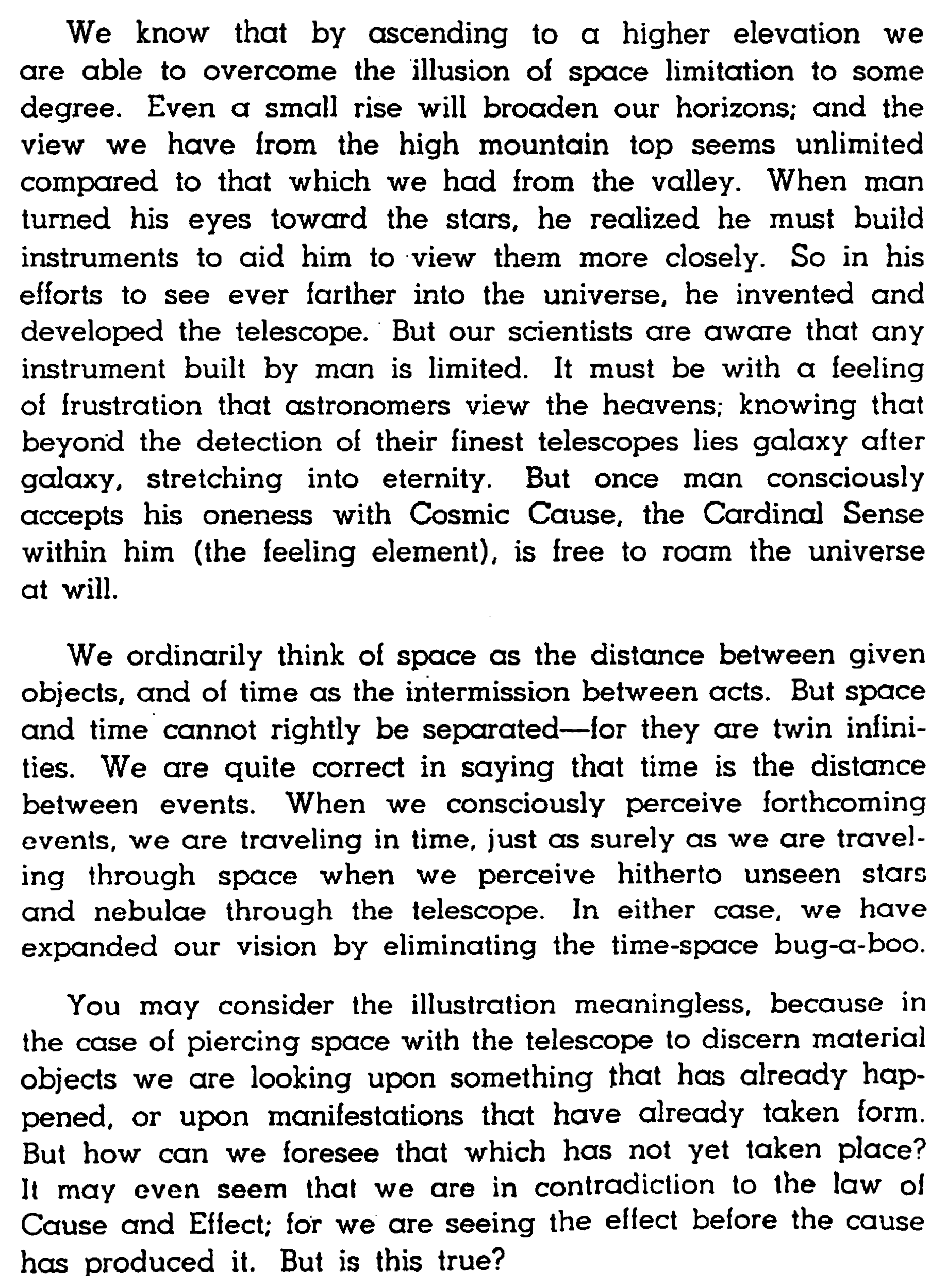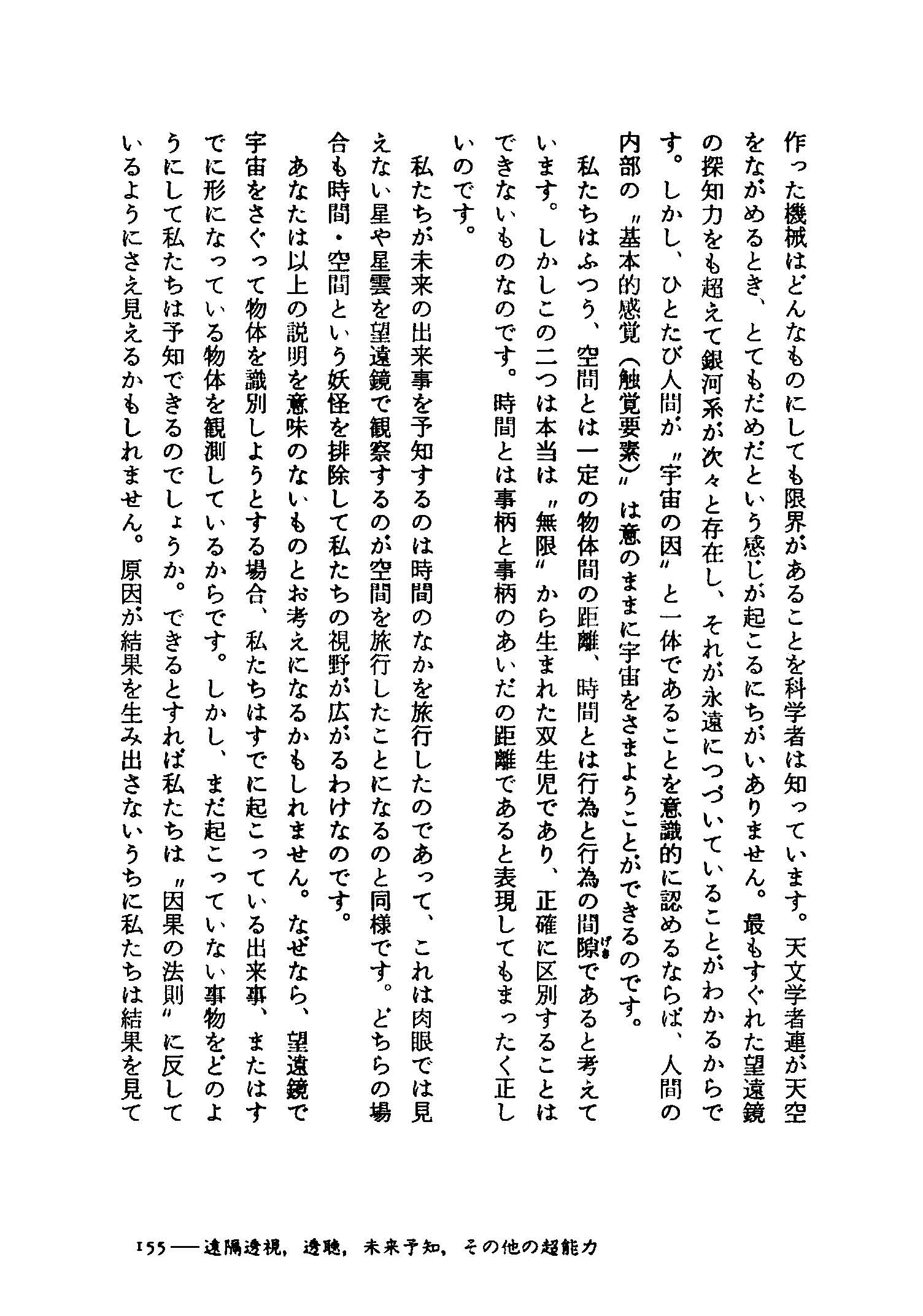時間と空間は双生児
時間と空間は双生児
高地に登ることによってある程度空間の制限という幻影に打ち勝つことができることを私たちは知っています。
We know that by ascending to a higher elevation we are able to overcome the illusion of space limitation to some degree.
小さな丘でさえも自分の視界は広がりますし、
Even a small rise will broaden our horizons;
高い山の頂上から見る眺めは谷から見る眺めにくらべて無限であるかのように見えます。
and the view we have from the high mountain top seems unlimited compared to that which we had from the valley.
人間が星々ヘ目を移したとき、もっとくわしくながめさせてくれる機械装置を作る必要があることに気づきました。
When man turned his eyes toward the stars, he realized he must build instruments to aid him to view them more closely.
そこで、宇宙の遠方を見ようと努力して人間は望遠鏡を発明し、これを発達させました。
So in his efforts to see ever farther into the universe, he invented and developed the telescope.
しかし人間の作った機械はどんなものにしても限界があることを科学者は知っています。
But our scientists are aware that any instrument built by man is limited.
天文学者連が天空をながめるとき、とてもだめだという感じが起こるにちがいありません。
It must be with a feeling of frustration that astronomers view the heavens;
最もすぐれた望遠鏡の探知力をも超えて銀河系が次々と存在し、それが永遠につづいていることがわかるからです。
knowing that beyond the detection of their finest telescopes lies galaxy after galaxy, stretching into eternity.
しかし、ひとたび人間が”宇宙の因”と一体であることを意識的に認めるならば、人間の内部の”基本的感覚(触覚要素)”は意のままに宇宙をさまようことができるのです。
But once man consciously accepts his oneness with Cosmic Cause, the Cardinal Sense within him (the feeling element), is free to roam the universe at will.
私たちはふつう、空間とは一定の物体間の距離、時間とは行為と行為の間隙であると考えています。
We ordinarily think of space as the distance between given objects, and of time as the intermission between acts.
しかしこの二つは本当は”無限”から生まれた双生児であり、正確に区別することはできないものなのです。
But space and time cannot rightly be separated - for they are twin infinities.
時問とは事柄と事納のあいだの距離であると表現してもまったく正しいのです。
We are quite correct in saying that time is the distance between events.
私たちが未来の出来事を予知するのは時間のなかを旅行したのであって、これは肉眼では見えない星や星雲を望遠鏡で観察するのが空間を旅行したことになるのと同様です。
When we consciously perceive forthcoming events, we are traveling in time, just as surely as we are traveling through space when we perceive hitherto unseen stars and nebulae through the telescope.
どちらの場合も時間・空間という妖怪を排除して私たちの視野が広がるわけなのです。
In either case, we have expanded our vision by eliminating the time-space bug-a-boo.
あなたは以上の説明を意味のないものとお考えになるかもしれません。なぜなら、望遠鏡で宇宙をさぐって物体を識別しようとする場合、私たちはすでに起こっている出来事、またはすでに形になっている物体を観測しているからです。
You may consider the illustration meaningless, because in the case of piercing space with the telescope to discern material objects we are looking upon something that has already happened, or upon manifestations that have already taken form.
しかし、まだ起こっていない事物をどのようにして私たちは予知できるのでしょうか。
But how can we foresee that which has not yet taken place?
できるとすれば私たちは”因果の法則”に反しているようにさえ見えるかもしれません。
It may even seem that we are in contradiction to the law of Cause and Effect;
原因が結果を生み出さないうちに私たちは結果を見ていることになるからです。
for we are seeing the effect before the cause has produced it.
これは果たして真実でしょうか。
But is this true?




[日本語訳] 久保田八郎 訳(中央アート出版社「超能力開発法」より)
[英語原文] TELEPATHY - THE COSMIC OR UNIVERSAL LANGUAGE by GEORGE ADAMSKI